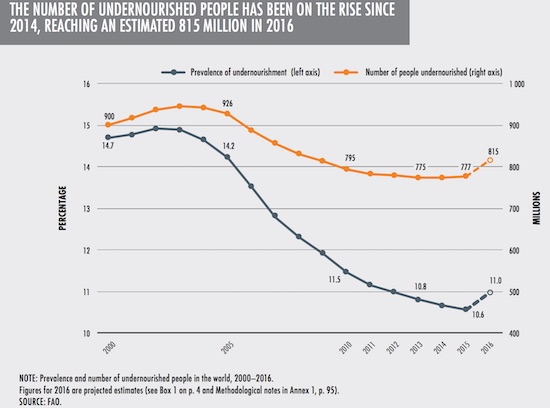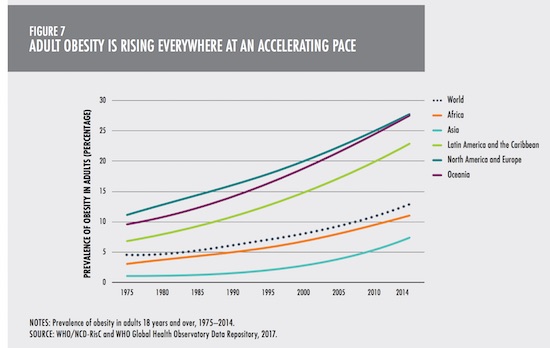Over 800 million people around the world are hungry for more. Conflicts and climate change are the cause.

Bad news on the food front. For the first time in a long time, the number of hungry people is on the rise again. In 2016, 815 million people did not eat enough. This is undoubtedly the most alarming data that emerges from the last report on food security in the world, issued by the United Nations and its specialized agencies. This decline threatens 2030 targets for sustainable development.
The UN set the course in 2015: within 15 years, famine and undernourishment must be eradicated from the planet. An ambition which was, until now, on the right track. But the latest observations make hope fade away. Between 2015 and 2016, the number of undernourished people increased. 11% of the world’s population now suffer from hunger.

Source : FAO
Unsolvable conflicts
Direct result of this lack of availability: the youngest do not grow up as they should. 23% of children under 5 suffer from stunted growth. And 52 million are underweight for their height.
The last few years have been marked by the emergence of numerous regional conflicts, explains the UN in its report. And many of these have thrown an already delicate situation off balance. Yemen, for example, faces an endless civil war. To this scourge have been added, more recently, large-scale natural disasters: floods, torrential rains and tropical cyclones have worsened the food insecurity from which the Yemeni population suffers.
“During the last decade, conflicts have become more numerous, more complex and more intractable,” say the presidents of the organizations signing this document. We will not end hunger and malnutrition by 2030 if we do not find a solution to all the factors that undermine food and nutrition security. The solution: ensure lasting peace in the affected countries, as well as equality in access to food.
Natural disasters on the rise
Because the inequalities are glaring on a global scale but also on a regional scale. Some areas are disproportionately impacted by food insecurity and undernourishment. On the African continent, 20% of the population does not have enough to eat. In Latin America, only 6.5% suffer from the same problem.
But conflicts are not the only cause of this difficult access. More peaceful areas, such as Latin America, are also threatened by natural climatic phenomena – such as El Niño, causing floods or drought. These affect the quantity of crops as well as their quality. This promotes, in addition to undernourishment, the occurrence of malnutrition – that is to say a deficiency in macronutrients and micronutrients. Anemia is particularly problematic in pregnant women.
Cumulative factors
Climate and conflict are to blame, but the change in eating habits is also of concern to the United Nations. Especially if it is combined with pre-existing elements. However, the control of the food industry on the market has perverse effects.
By promoting access to prepared foods, manufacturers and distributors limit access to traditional consumption patterns. And overweight is exploding, especially in the most favored regions. Thus, the obesity rate reaches 28% in North America, Europe or Oceania. Conversely, regions such as Asia and Africa are less affected.

The problem is that risk factors tend to accumulate and the term malnutrition can describe very different realities in different countries. In Egypt or Iraq, for example, more than 20% of children under 5 are stunted… and the same proportion of the adult population is affected by obesity. In fact, only two countries face only one cause of malnutrition: Japan and South Korea.
.















